Medigood Case Study: Developing New Information System for Healthcare
VerifiedAdded on 2023/06/11
|15
|2638
|255
Case Study
AI Summary
This case study focuses on the development of a new information system for Medigood, aiming to resolve issues with their current system and improve operational efficiency. The new system facilitates effective handling of organizational operations by ensuring specialist availability. The work breakdown structure outlines the project's phases, from analysis to implementation and ongoing support. A 'to-be' design activity diagram illustrates the improved business process, while organizational changes resulting from the new system are managed through careful planning. Screen designs for new users and available specialists are presented, along with acceptance criteria based on client needs and software development methodology. The application architecture details the system's modules for patient care and managerial functions. The report concludes with a comparison of Agile and Waterfall methodologies, highlighting the reasons for choosing the Waterfall model for this project.

Running head: CASE STUDY: MEDIGOOD
Case Study-Medigood
Name of the Student
Name of the University
Author’s Note
Case Study-Medigood
Name of the Student
Name of the University
Author’s Note
Paraphrase This Document
Need a fresh take? Get an instant paraphrase of this document with our AI Paraphraser

1
CASE STUDY: MEDIGOOD
Table of Contents
Overview....................................................................................................................................2
2.1 Work breakdown structure.............................................................................................2
2.2 To-be design activity diagram..........................................................................................4
Figure 1: To-be design activity diagram................................................................................4
2.3 Organizational change......................................................................................................4
2.4 Screen design...................................................................................................................6
2.5 Acceptance criteria...........................................................................................................7
2.6 Applications architecture.................................................................................................8
2.7 Report to client.................................................................................................................9
2.8 Agile and Waterfall difference.........................................................................................9
References................................................................................................................................11
Appendices...............................................................................................................................13
CASE STUDY: MEDIGOOD
Table of Contents
Overview....................................................................................................................................2
2.1 Work breakdown structure.............................................................................................2
2.2 To-be design activity diagram..........................................................................................4
Figure 1: To-be design activity diagram................................................................................4
2.3 Organizational change......................................................................................................4
2.4 Screen design...................................................................................................................6
2.5 Acceptance criteria...........................................................................................................7
2.6 Applications architecture.................................................................................................8
2.7 Report to client.................................................................................................................9
2.8 Agile and Waterfall difference.........................................................................................9
References................................................................................................................................11
Appendices...............................................................................................................................13

2
CASE STUDY: MEDIGOOD
Overview
The paper mainly focusses on the development of new information system for the
organization “Medigood” in order to resolve all the issues and challenges that are associated
with the present system of the organization. In addition to this, the new system is mainly
developed so that the operations of the organization can be effectively handled after checking
proper availability of the specialist.
2.1 Work breakdown structure
The work breakdown structure for the project is reflected in the table below:
WBS Task Name Duration
0 Development patient care system for Medigood 63 days
1 Analysis phase of development 28 days
1.1 Analyzing system requirements 22 days
1.1.1 Conduction of interviews 4 days
1.1.2 Conduction of documentation 7 days
1.1.3 Conducting reviews 8 days
1.1.4 Conducting surveys 9 days
1.1.5 Conducting research 10 days
1.2 Modelling data and processes 9 days
1.3 Building in house of the system 8 days
2 System design phase 22 days
2.1 Developing user interface 10 days
2.2 Data design 14 days
2.3 Designing new system architecture 12 days
CASE STUDY: MEDIGOOD
Overview
The paper mainly focusses on the development of new information system for the
organization “Medigood” in order to resolve all the issues and challenges that are associated
with the present system of the organization. In addition to this, the new system is mainly
developed so that the operations of the organization can be effectively handled after checking
proper availability of the specialist.
2.1 Work breakdown structure
The work breakdown structure for the project is reflected in the table below:
WBS Task Name Duration
0 Development patient care system for Medigood 63 days
1 Analysis phase of development 28 days
1.1 Analyzing system requirements 22 days
1.1.1 Conduction of interviews 4 days
1.1.2 Conduction of documentation 7 days
1.1.3 Conducting reviews 8 days
1.1.4 Conducting surveys 9 days
1.1.5 Conducting research 10 days
1.2 Modelling data and processes 9 days
1.3 Building in house of the system 8 days
2 System design phase 22 days
2.1 Developing user interface 10 days
2.2 Data design 14 days
2.3 Designing new system architecture 12 days
⊘ This is a preview!⊘
Do you want full access?
Subscribe today to unlock all pages.

Trusted by 1+ million students worldwide
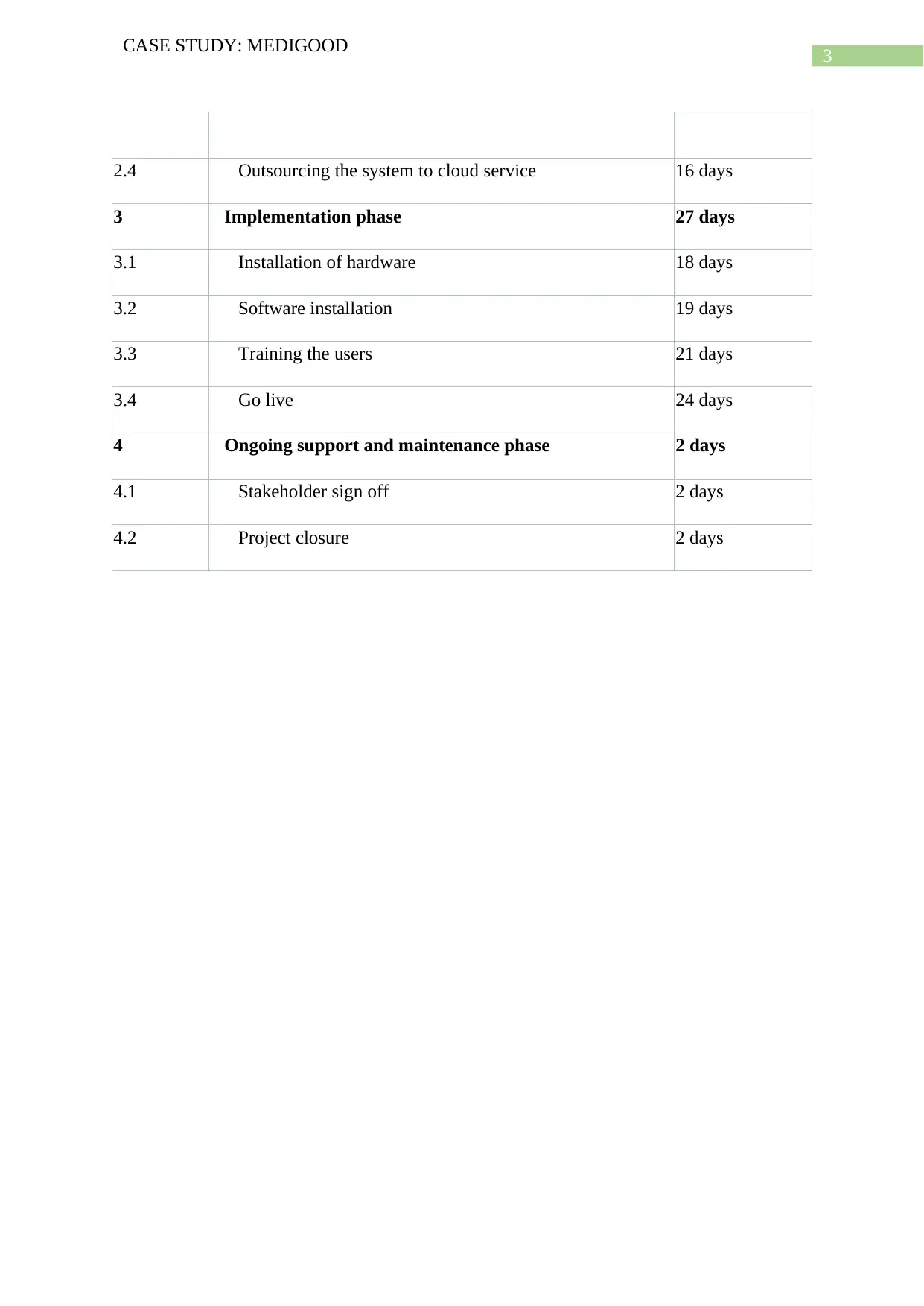
3
CASE STUDY: MEDIGOOD
2.4 Outsourcing the system to cloud service 16 days
3 Implementation phase 27 days
3.1 Installation of hardware 18 days
3.2 Software installation 19 days
3.3 Training the users 21 days
3.4 Go live 24 days
4 Ongoing support and maintenance phase 2 days
4.1 Stakeholder sign off 2 days
4.2 Project closure 2 days
CASE STUDY: MEDIGOOD
2.4 Outsourcing the system to cloud service 16 days
3 Implementation phase 27 days
3.1 Installation of hardware 18 days
3.2 Software installation 19 days
3.3 Training the users 21 days
3.4 Go live 24 days
4 Ongoing support and maintenance phase 2 days
4.1 Stakeholder sign off 2 days
4.2 Project closure 2 days
Paraphrase This Document
Need a fresh take? Get an instant paraphrase of this document with our AI Paraphraser
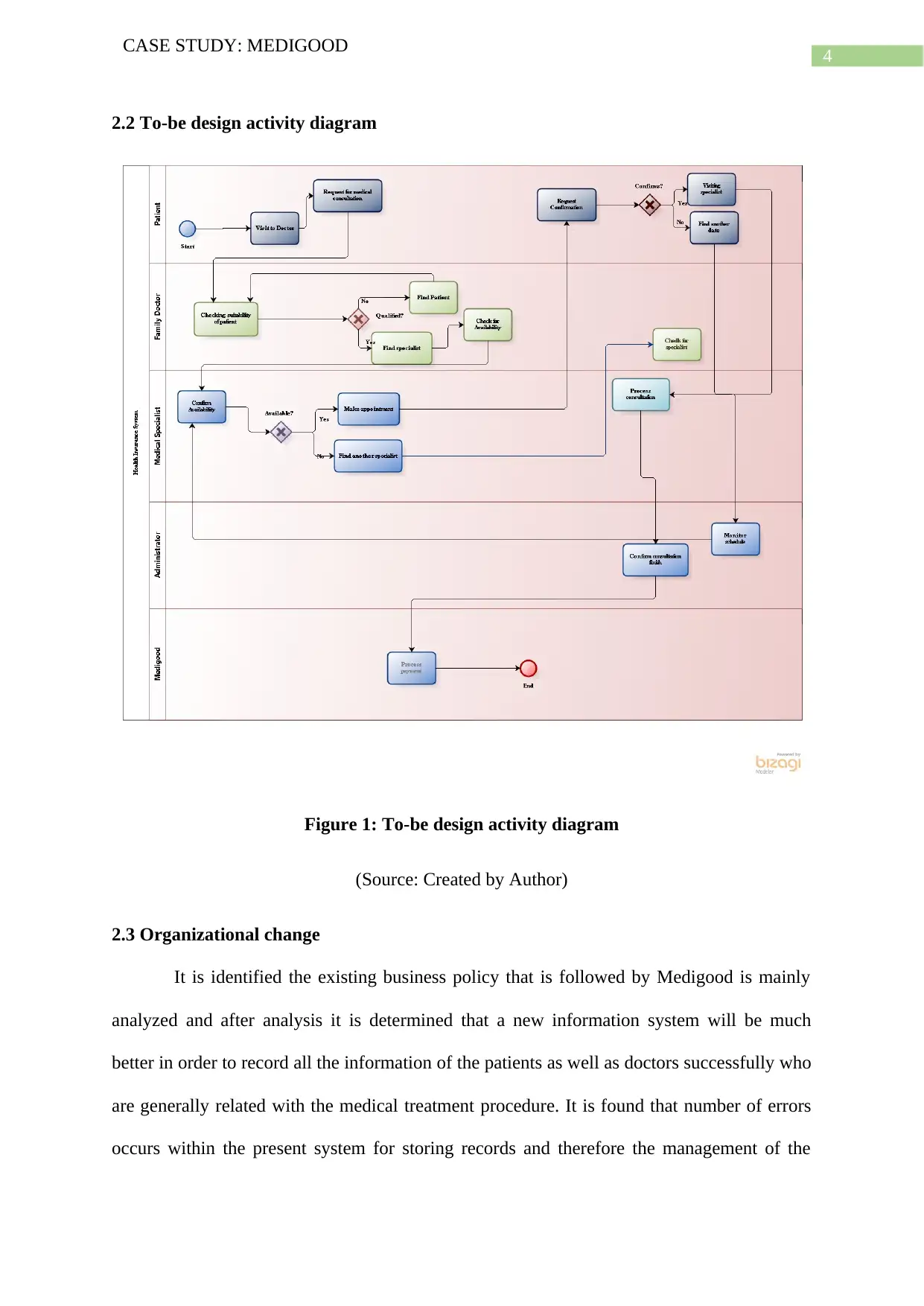
4
CASE STUDY: MEDIGOOD
2.2 To-be design activity diagram
Figure 1: To-be design activity diagram
(Source: Created by Author)
2.3 Organizational change
It is identified the existing business policy that is followed by Medigood is mainly
analyzed and after analysis it is determined that a new information system will be much
better in order to record all the information of the patients as well as doctors successfully who
are generally related with the medical treatment procedure. It is found that number of errors
occurs within the present system for storing records and therefore the management of the
CASE STUDY: MEDIGOOD
2.2 To-be design activity diagram
Figure 1: To-be design activity diagram
(Source: Created by Author)
2.3 Organizational change
It is identified the existing business policy that is followed by Medigood is mainly
analyzed and after analysis it is determined that a new information system will be much
better in order to record all the information of the patients as well as doctors successfully who
are generally related with the medical treatment procedure. It is found that number of errors
occurs within the present system for storing records and therefore the management of the
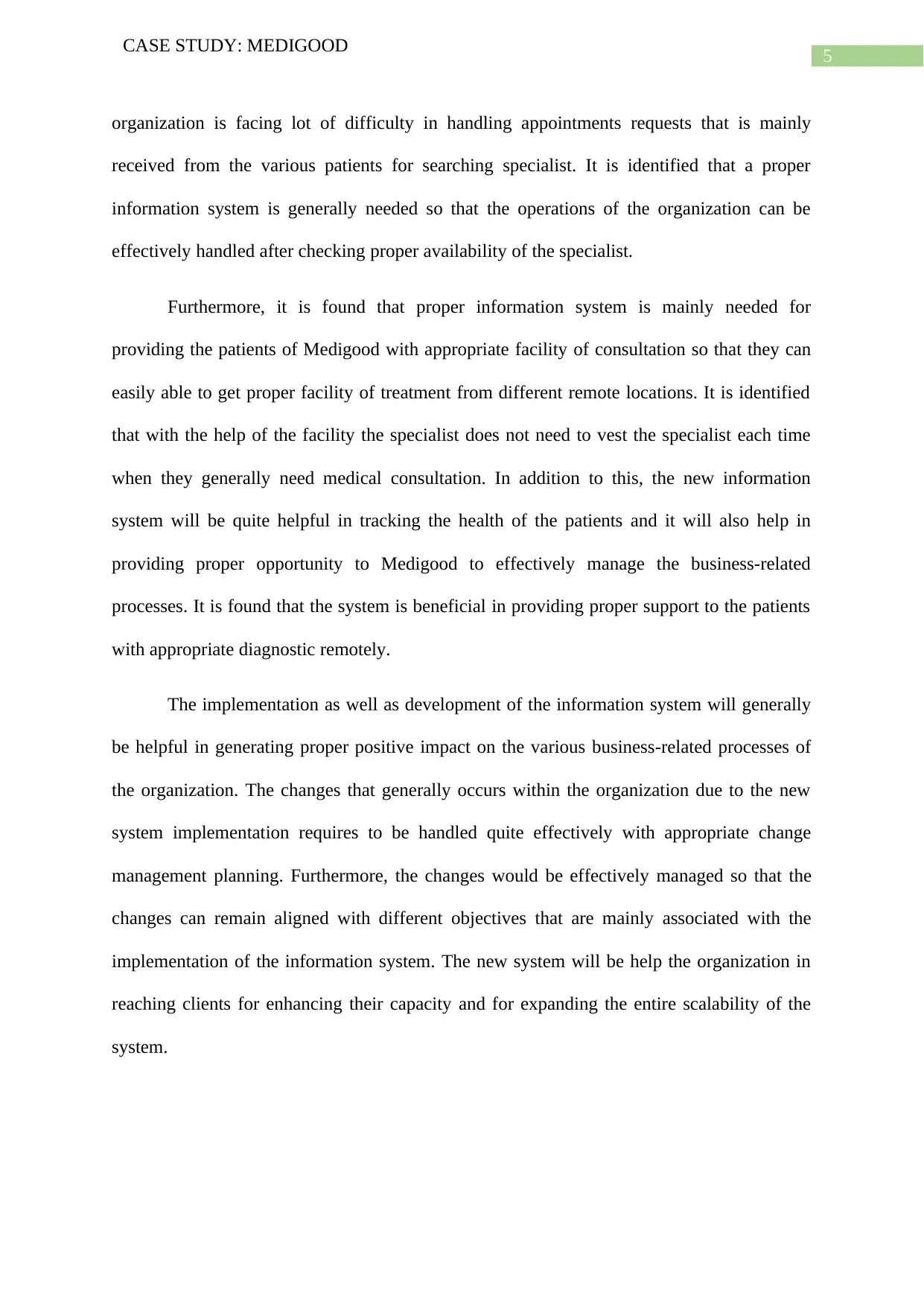
5
CASE STUDY: MEDIGOOD
organization is facing lot of difficulty in handling appointments requests that is mainly
received from the various patients for searching specialist. It is identified that a proper
information system is generally needed so that the operations of the organization can be
effectively handled after checking proper availability of the specialist.
Furthermore, it is found that proper information system is mainly needed for
providing the patients of Medigood with appropriate facility of consultation so that they can
easily able to get proper facility of treatment from different remote locations. It is identified
that with the help of the facility the specialist does not need to vest the specialist each time
when they generally need medical consultation. In addition to this, the new information
system will be quite helpful in tracking the health of the patients and it will also help in
providing proper opportunity to Medigood to effectively manage the business-related
processes. It is found that the system is beneficial in providing proper support to the patients
with appropriate diagnostic remotely.
The implementation as well as development of the information system will generally
be helpful in generating proper positive impact on the various business-related processes of
the organization. The changes that generally occurs within the organization due to the new
system implementation requires to be handled quite effectively with appropriate change
management planning. Furthermore, the changes would be effectively managed so that the
changes can remain aligned with different objectives that are mainly associated with the
implementation of the information system. The new system will be help the organization in
reaching clients for enhancing their capacity and for expanding the entire scalability of the
system.
CASE STUDY: MEDIGOOD
organization is facing lot of difficulty in handling appointments requests that is mainly
received from the various patients for searching specialist. It is identified that a proper
information system is generally needed so that the operations of the organization can be
effectively handled after checking proper availability of the specialist.
Furthermore, it is found that proper information system is mainly needed for
providing the patients of Medigood with appropriate facility of consultation so that they can
easily able to get proper facility of treatment from different remote locations. It is identified
that with the help of the facility the specialist does not need to vest the specialist each time
when they generally need medical consultation. In addition to this, the new information
system will be quite helpful in tracking the health of the patients and it will also help in
providing proper opportunity to Medigood to effectively manage the business-related
processes. It is found that the system is beneficial in providing proper support to the patients
with appropriate diagnostic remotely.
The implementation as well as development of the information system will generally
be helpful in generating proper positive impact on the various business-related processes of
the organization. The changes that generally occurs within the organization due to the new
system implementation requires to be handled quite effectively with appropriate change
management planning. Furthermore, the changes would be effectively managed so that the
changes can remain aligned with different objectives that are mainly associated with the
implementation of the information system. The new system will be help the organization in
reaching clients for enhancing their capacity and for expanding the entire scalability of the
system.
⊘ This is a preview!⊘
Do you want full access?
Subscribe today to unlock all pages.

Trusted by 1+ million students worldwide

6
CASE STUDY: MEDIGOOD
2.4 Screen design
New User (Appointment Booking)
Figure 2: Screen design for New User (Appointment Booking)
(Source: Created by Author)
Available Specialists
Figure 3: Screen design for available Specialists
(Source: Created by Author)
CASE STUDY: MEDIGOOD
2.4 Screen design
New User (Appointment Booking)
Figure 2: Screen design for New User (Appointment Booking)
(Source: Created by Author)
Available Specialists
Figure 3: Screen design for available Specialists
(Source: Created by Author)
Paraphrase This Document
Need a fresh take? Get an instant paraphrase of this document with our AI Paraphraser
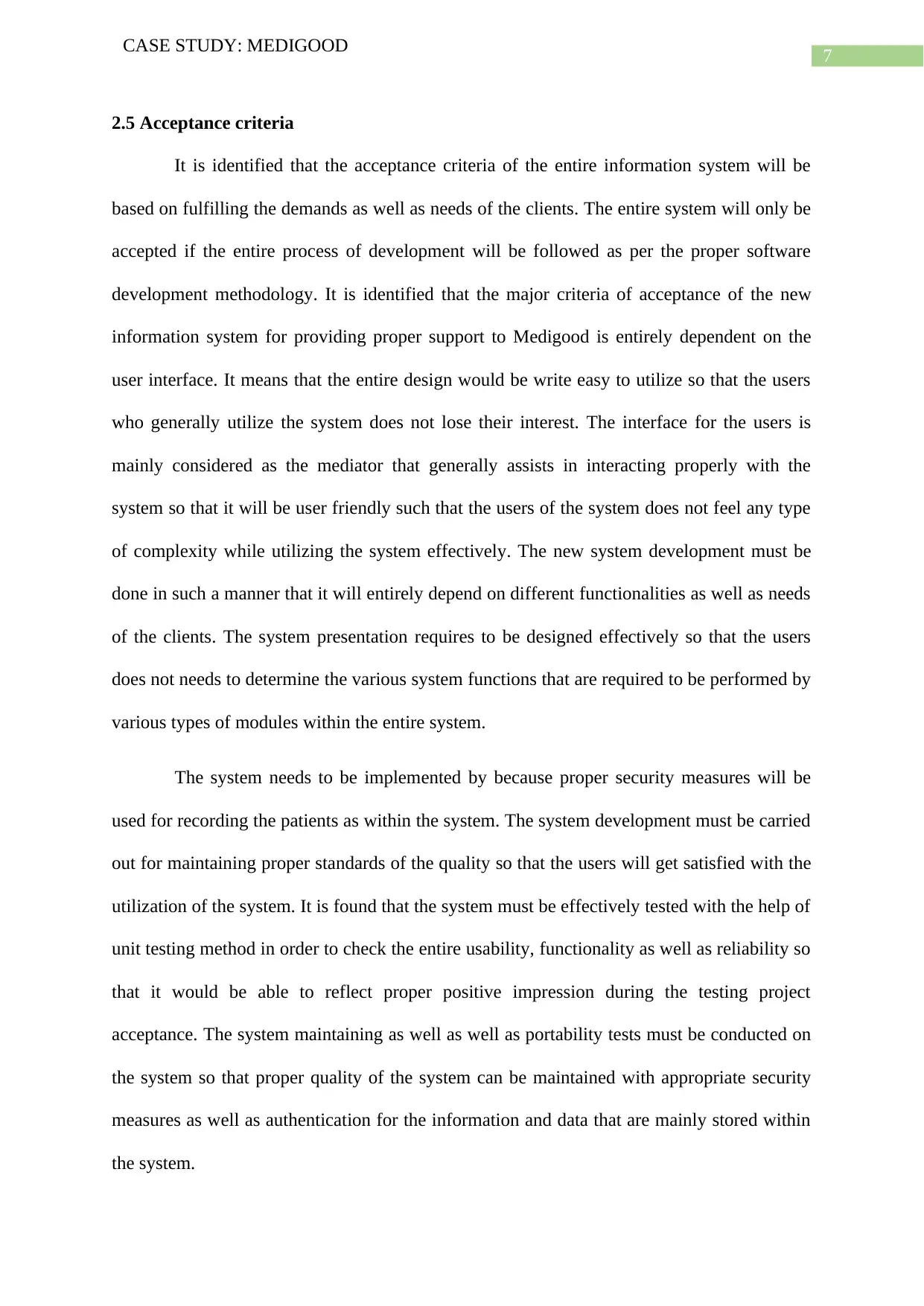
7
CASE STUDY: MEDIGOOD
2.5 Acceptance criteria
It is identified that the acceptance criteria of the entire information system will be
based on fulfilling the demands as well as needs of the clients. The entire system will only be
accepted if the entire process of development will be followed as per the proper software
development methodology. It is identified that the major criteria of acceptance of the new
information system for providing proper support to Medigood is entirely dependent on the
user interface. It means that the entire design would be write easy to utilize so that the users
who generally utilize the system does not lose their interest. The interface for the users is
mainly considered as the mediator that generally assists in interacting properly with the
system so that it will be user friendly such that the users of the system does not feel any type
of complexity while utilizing the system effectively. The new system development must be
done in such a manner that it will entirely depend on different functionalities as well as needs
of the clients. The system presentation requires to be designed effectively so that the users
does not needs to determine the various system functions that are required to be performed by
various types of modules within the entire system.
The system needs to be implemented by because proper security measures will be
used for recording the patients as within the system. The system development must be carried
out for maintaining proper standards of the quality so that the users will get satisfied with the
utilization of the system. It is found that the system must be effectively tested with the help of
unit testing method in order to check the entire usability, functionality as well as reliability so
that it would be able to reflect proper positive impression during the testing project
acceptance. The system maintaining as well as well as portability tests must be conducted on
the system so that proper quality of the system can be maintained with appropriate security
measures as well as authentication for the information and data that are mainly stored within
the system.
CASE STUDY: MEDIGOOD
2.5 Acceptance criteria
It is identified that the acceptance criteria of the entire information system will be
based on fulfilling the demands as well as needs of the clients. The entire system will only be
accepted if the entire process of development will be followed as per the proper software
development methodology. It is identified that the major criteria of acceptance of the new
information system for providing proper support to Medigood is entirely dependent on the
user interface. It means that the entire design would be write easy to utilize so that the users
who generally utilize the system does not lose their interest. The interface for the users is
mainly considered as the mediator that generally assists in interacting properly with the
system so that it will be user friendly such that the users of the system does not feel any type
of complexity while utilizing the system effectively. The new system development must be
done in such a manner that it will entirely depend on different functionalities as well as needs
of the clients. The system presentation requires to be designed effectively so that the users
does not needs to determine the various system functions that are required to be performed by
various types of modules within the entire system.
The system needs to be implemented by because proper security measures will be
used for recording the patients as within the system. The system development must be carried
out for maintaining proper standards of the quality so that the users will get satisfied with the
utilization of the system. It is found that the system must be effectively tested with the help of
unit testing method in order to check the entire usability, functionality as well as reliability so
that it would be able to reflect proper positive impression during the testing project
acceptance. The system maintaining as well as well as portability tests must be conducted on
the system so that proper quality of the system can be maintained with appropriate security
measures as well as authentication for the information and data that are mainly stored within
the system.
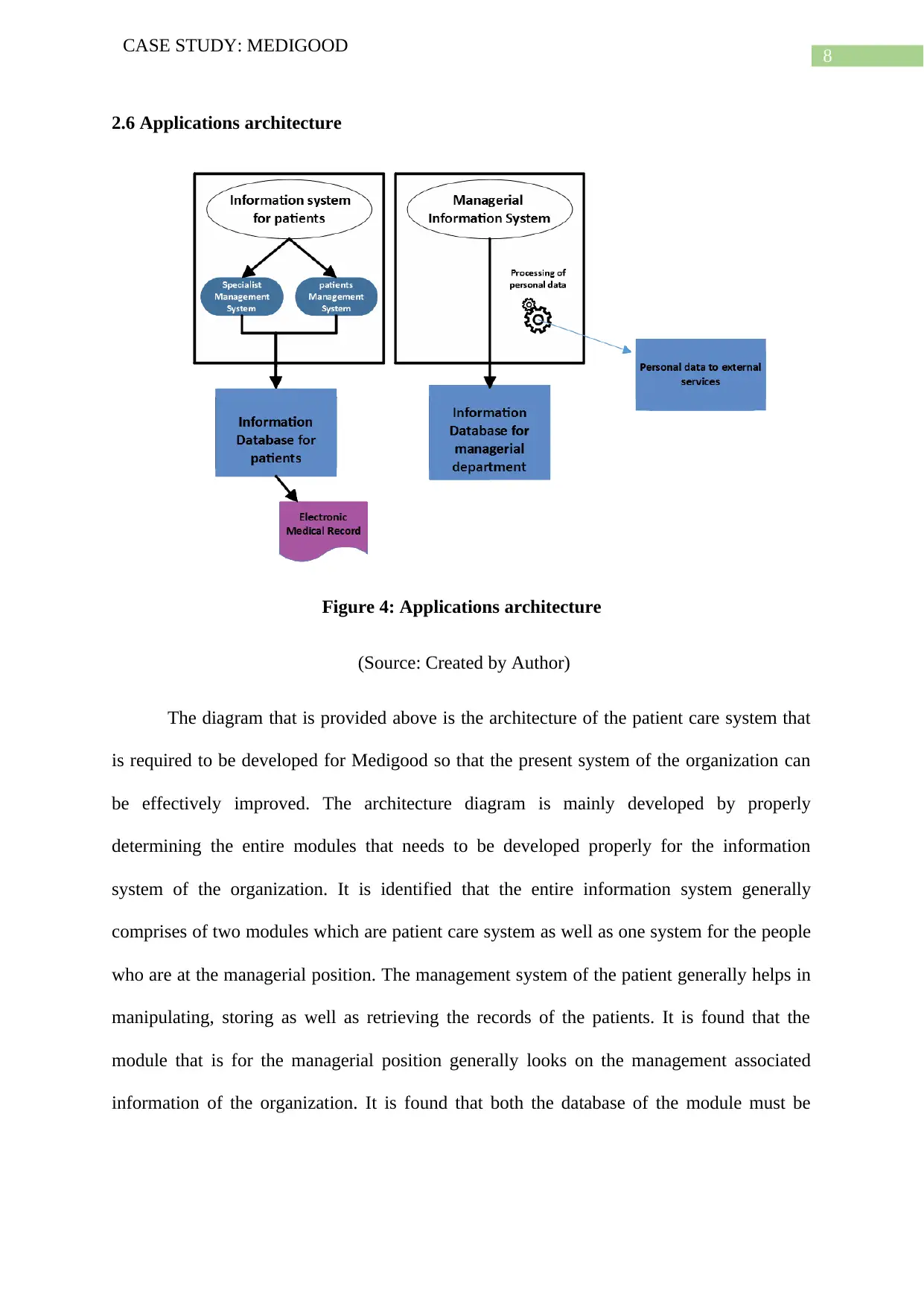
8
CASE STUDY: MEDIGOOD
2.6 Applications architecture
Figure 4: Applications architecture
(Source: Created by Author)
The diagram that is provided above is the architecture of the patient care system that
is required to be developed for Medigood so that the present system of the organization can
be effectively improved. The architecture diagram is mainly developed by properly
determining the entire modules that needs to be developed properly for the information
system of the organization. It is identified that the entire information system generally
comprises of two modules which are patient care system as well as one system for the people
who are at the managerial position. The management system of the patient generally helps in
manipulating, storing as well as retrieving the records of the patients. It is found that the
module that is for the managerial position generally looks on the management associated
information of the organization. It is found that both the database of the module must be
CASE STUDY: MEDIGOOD
2.6 Applications architecture
Figure 4: Applications architecture
(Source: Created by Author)
The diagram that is provided above is the architecture of the patient care system that
is required to be developed for Medigood so that the present system of the organization can
be effectively improved. The architecture diagram is mainly developed by properly
determining the entire modules that needs to be developed properly for the information
system of the organization. It is identified that the entire information system generally
comprises of two modules which are patient care system as well as one system for the people
who are at the managerial position. The management system of the patient generally helps in
manipulating, storing as well as retrieving the records of the patients. It is found that the
module that is for the managerial position generally looks on the management associated
information of the organization. It is found that both the database of the module must be
⊘ This is a preview!⊘
Do you want full access?
Subscribe today to unlock all pages.

Trusted by 1+ million students worldwide

9
CASE STUDY: MEDIGOOD
properly separated so that the entire backup as well as recovery will be generally conducted
easily in case of failure.
2.7 Report to client
The report mainly focusses on elaborating the processes that are generally utilized for
making proper decision in order to develop the entire information system successfully. It is
identified that entire choice for development of information system is in-house that means the
developers are mainly recruited so that proper system will be developed with appropriate
collaboration with Medigood. The existing business policy of the organization required to be
identified in order to determine various needs as well as requirements of the stakeholders who
are generally related with the organization. The new system will generally be proposed in
order to connect the patients with the various medical consultants as well as specialist so that
they do not need to visit the clinic every time they require consultation.
It is identified that Waterfall model is mainly selected in this project while developing
the new information system for the organization in order to minimize the time that is
generally needed in order to develop the system quite effectively. It is identified that selection
of appropriate supplier is quite important for successful development of proper information
system as the procurement of every materials on time and with quality generally assists in
ensuring proper success of the system.
2.8 Agile and Waterfall difference
There are number of methodologies that needs to be properly implemented in order to
develop the software effectively so that various approaches that are mainly related with
software development methodologies. It is found that traditional waterfall model is one of the
most primitive methodology that is generally utilized in order to develop the system. The
agile methodology is mainly utilized in order to develop various types of software products
CASE STUDY: MEDIGOOD
properly separated so that the entire backup as well as recovery will be generally conducted
easily in case of failure.
2.7 Report to client
The report mainly focusses on elaborating the processes that are generally utilized for
making proper decision in order to develop the entire information system successfully. It is
identified that entire choice for development of information system is in-house that means the
developers are mainly recruited so that proper system will be developed with appropriate
collaboration with Medigood. The existing business policy of the organization required to be
identified in order to determine various needs as well as requirements of the stakeholders who
are generally related with the organization. The new system will generally be proposed in
order to connect the patients with the various medical consultants as well as specialist so that
they do not need to visit the clinic every time they require consultation.
It is identified that Waterfall model is mainly selected in this project while developing
the new information system for the organization in order to minimize the time that is
generally needed in order to develop the system quite effectively. It is identified that selection
of appropriate supplier is quite important for successful development of proper information
system as the procurement of every materials on time and with quality generally assists in
ensuring proper success of the system.
2.8 Agile and Waterfall difference
There are number of methodologies that needs to be properly implemented in order to
develop the software effectively so that various approaches that are mainly related with
software development methodologies. It is found that traditional waterfall model is one of the
most primitive methodology that is generally utilized in order to develop the system. The
agile methodology is mainly utilized in order to develop various types of software products
Paraphrase This Document
Need a fresh take? Get an instant paraphrase of this document with our AI Paraphraser
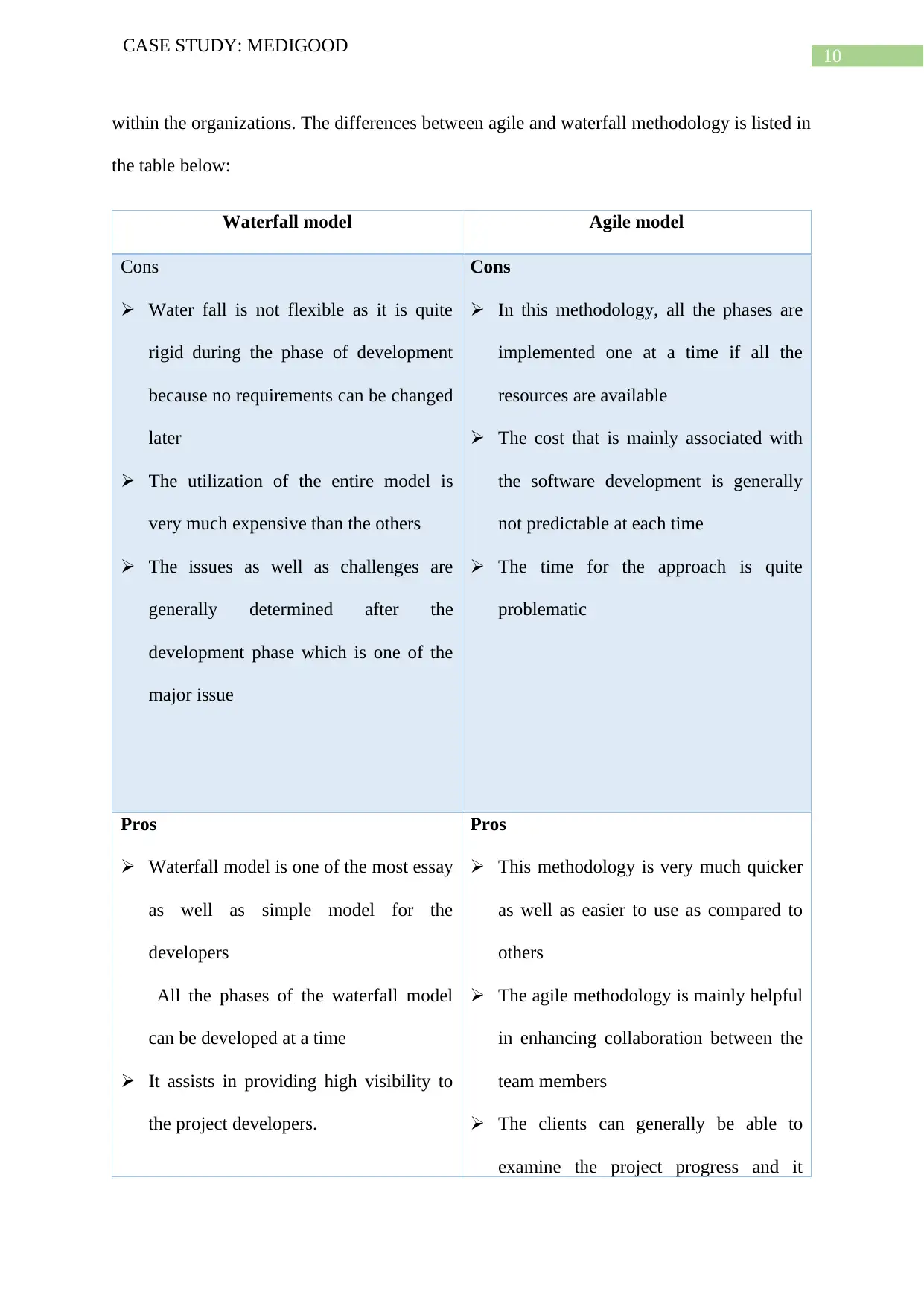
10
CASE STUDY: MEDIGOOD
within the organizations. The differences between agile and waterfall methodology is listed in
the table below:
Waterfall model Agile model
Cons
Water fall is not flexible as it is quite
rigid during the phase of development
because no requirements can be changed
later
The utilization of the entire model is
very much expensive than the others
The issues as well as challenges are
generally determined after the
development phase which is one of the
major issue
Cons
In this methodology, all the phases are
implemented one at a time if all the
resources are available
The cost that is mainly associated with
the software development is generally
not predictable at each time
The time for the approach is quite
problematic
Pros
Waterfall model is one of the most essay
as well as simple model for the
developers
All the phases of the waterfall model
can be developed at a time
It assists in providing high visibility to
the project developers.
Pros
This methodology is very much quicker
as well as easier to use as compared to
others
The agile methodology is mainly helpful
in enhancing collaboration between the
team members
The clients can generally be able to
examine the project progress and it
CASE STUDY: MEDIGOOD
within the organizations. The differences between agile and waterfall methodology is listed in
the table below:
Waterfall model Agile model
Cons
Water fall is not flexible as it is quite
rigid during the phase of development
because no requirements can be changed
later
The utilization of the entire model is
very much expensive than the others
The issues as well as challenges are
generally determined after the
development phase which is one of the
major issue
Cons
In this methodology, all the phases are
implemented one at a time if all the
resources are available
The cost that is mainly associated with
the software development is generally
not predictable at each time
The time for the approach is quite
problematic
Pros
Waterfall model is one of the most essay
as well as simple model for the
developers
All the phases of the waterfall model
can be developed at a time
It assists in providing high visibility to
the project developers.
Pros
This methodology is very much quicker
as well as easier to use as compared to
others
The agile methodology is mainly helpful
in enhancing collaboration between the
team members
The clients can generally be able to
examine the project progress and it
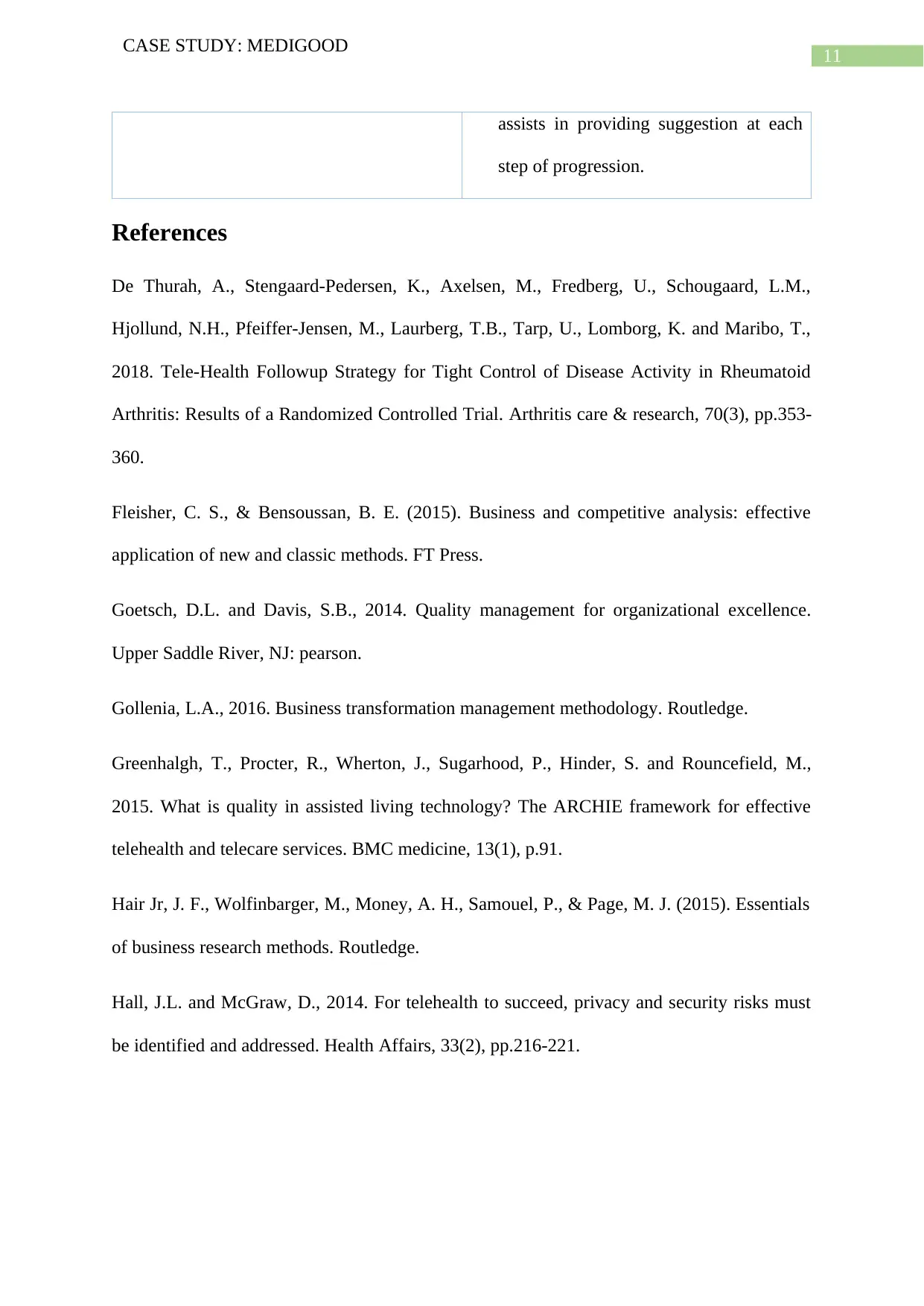
11
CASE STUDY: MEDIGOOD
assists in providing suggestion at each
step of progression.
References
De Thurah, A., Stengaard‐Pedersen, K., Axelsen, M., Fredberg, U., Schougaard, L.M.,
Hjollund, N.H., Pfeiffer‐Jensen, M., Laurberg, T.B., Tarp, U., Lomborg, K. and Maribo, T.,
2018. Tele‐Health Followup Strategy for Tight Control of Disease Activity in Rheumatoid
Arthritis: Results of a Randomized Controlled Trial. Arthritis care & research, 70(3), pp.353-
360.
Fleisher, C. S., & Bensoussan, B. E. (2015). Business and competitive analysis: effective
application of new and classic methods. FT Press.
Goetsch, D.L. and Davis, S.B., 2014. Quality management for organizational excellence.
Upper Saddle River, NJ: pearson.
Gollenia, L.A., 2016. Business transformation management methodology. Routledge.
Greenhalgh, T., Procter, R., Wherton, J., Sugarhood, P., Hinder, S. and Rouncefield, M.,
2015. What is quality in assisted living technology? The ARCHIE framework for effective
telehealth and telecare services. BMC medicine, 13(1), p.91.
Hair Jr, J. F., Wolfinbarger, M., Money, A. H., Samouel, P., & Page, M. J. (2015). Essentials
of business research methods. Routledge.
Hall, J.L. and McGraw, D., 2014. For telehealth to succeed, privacy and security risks must
be identified and addressed. Health Affairs, 33(2), pp.216-221.
CASE STUDY: MEDIGOOD
assists in providing suggestion at each
step of progression.
References
De Thurah, A., Stengaard‐Pedersen, K., Axelsen, M., Fredberg, U., Schougaard, L.M.,
Hjollund, N.H., Pfeiffer‐Jensen, M., Laurberg, T.B., Tarp, U., Lomborg, K. and Maribo, T.,
2018. Tele‐Health Followup Strategy for Tight Control of Disease Activity in Rheumatoid
Arthritis: Results of a Randomized Controlled Trial. Arthritis care & research, 70(3), pp.353-
360.
Fleisher, C. S., & Bensoussan, B. E. (2015). Business and competitive analysis: effective
application of new and classic methods. FT Press.
Goetsch, D.L. and Davis, S.B., 2014. Quality management for organizational excellence.
Upper Saddle River, NJ: pearson.
Gollenia, L.A., 2016. Business transformation management methodology. Routledge.
Greenhalgh, T., Procter, R., Wherton, J., Sugarhood, P., Hinder, S. and Rouncefield, M.,
2015. What is quality in assisted living technology? The ARCHIE framework for effective
telehealth and telecare services. BMC medicine, 13(1), p.91.
Hair Jr, J. F., Wolfinbarger, M., Money, A. H., Samouel, P., & Page, M. J. (2015). Essentials
of business research methods. Routledge.
Hall, J.L. and McGraw, D., 2014. For telehealth to succeed, privacy and security risks must
be identified and addressed. Health Affairs, 33(2), pp.216-221.
⊘ This is a preview!⊘
Do you want full access?
Subscribe today to unlock all pages.

Trusted by 1+ million students worldwide
1 out of 15
Related Documents
Your All-in-One AI-Powered Toolkit for Academic Success.
+13062052269
info@desklib.com
Available 24*7 on WhatsApp / Email
![[object Object]](/_next/static/media/star-bottom.7253800d.svg)
Unlock your academic potential
Copyright © 2020–2025 A2Z Services. All Rights Reserved. Developed and managed by ZUCOL.




